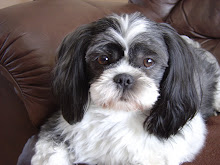
The Red Fox (Vulpes vulpes) is native to North America, Eurasia and northern Africa and it was introduced into Australia in the mid 1800's. At one time foxes were confined to the the wilds, however, the expansion of cities and towns into former wilderness areas has seen the fox become more bold in recent years. It is now possible to observe them wandering the streets like stray dogs.
This small canid is most commonly an orange-red colour, with black lower legs, black ear tips and top of the tail and white underbelly and tip of the tail. However, some morphs are black or black with a white tip on the tail and some are predominately red, ranging in shades from orange-red to dark red. They range in weight from 3.6 to 7.6 Kg (7.9 - 17 pounds) depending on where they live, with the largest ones found in Canada and Alaska. Some in these locales can weigh up to 14 Kg (31 pounds). Head and body length ranges from 46 to 90 cm (18 – 35 inches) with a tail of 30 to 55 cm (12 – 22 inches). Males tend to be about 15 percent heavier than females. Foxes generally live 3 to 5 years in the wild and 12 to 15 years in captivity. Foxes are extremely fast and can reach speeds up to 72 Km per hour (45 mph). This speed aids in catching prey and evading predators.
A few years ago, a female Red Fox with a black face, ears, back and legs showed up in Creighton, Saskatchewan, where I live. It was an offspring of a dark red male fox and a black female fox that used to hang around the mine site in nearby Flin Flon, Manitoba. This little fox was very friendly and an elderly neighbour used to feed it table scraps by hand. Even though foxes are usually crepuscular and even nocturnal, this fox, which Mom and Dad called “Pretty Lady,” patrolled our town all hours of the day and night. Mom and Dad found out that she liked wieners, so they always had a big bag of bulk wieners in the fridge. This fox would frequently jump up onto our front deck and “knock” on the front door with a paw. Mom or Dad would then peel the cellophane wrapper off a couple of wieners, cut them into pieces on a paper plate and put the paper plate on the front deck. She would eat her fill and then take any leftover pieces across the street and bury them on the edge of a vacant lot. If she didn't show up by the time we had finished supper, Dad would take a plate of wiener pieces and put it on the front deck and then whistle for the fox (similar to whistling for a dog). If she was within hearing distance, she would come running down the street and jump up onto the deck for her “supper.”
One night she was a little slow showing up and when she got to our house, she began to cry like a baby. Mom and Dad went to see what the problem was and discovered that a neighbour's cat was eating the wiener pieces. Dad chased the cat away and the fox jumped up onto the deck beside him and began eating.
I guess the Natural Resources officer felt that the fox was getting too tame, because when spring arrived, he caught her in a live trap and took her 300 Kilometres out into the northern forest.
Last fall an older Red Fox showed up on our back deck one day. She had a big scar on her face starting near her left nostril and curving up over her nose and ending at the top of the right eye socket which was empty and badly scarred. Mom and Dad began feeding her and she became a nearly daily visitor. She wasn't quite as tame as “Pretty Lady,” but she was bold enough to climb through our gate and come onto the deck for food. She also liked wieners, but she would eat any meat or fish scraps we had on hand. She kept coming until March, when she went back into the forest. We all hope she comes back in the fall.
If captured at a young age, Red Foxes will make good domestic pets, however, in many areas, it is against the law to own a wild animal as a pet, so before considering getting a fox as a pet, check with your local authorities so that you don't find yourself in court.
Until next time,
Teia








